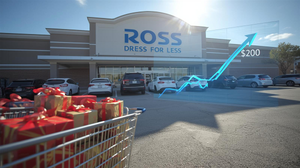
Off-price retail company Ross Stores (NASDAQ: ROST) fell short of the market’s revenue expectations in Q1 CY2025 as sales rose 2.6% year on year to $4.98 billion.
Is now the time to buy ROST? Find out in our full research report (it’s free).
Ross Stores (ROST) Q1 CY2025 Highlights:
- Operating Margin: 12.2%, in line with the same quarter last year
- Locations: 2,205 at quarter end, up from 2,127 in the same quarter last year
- Same-Store Sales were flat year on year (3% in the same quarter last year)
- Market Capitalization: $46.46 billion
StockStory’s Take
Ross Stores’ first quarter performance was shaped by a combination of flat same-store sales and an evolving merchandise mix, as management highlighted sequential improvement in monthly results following a slow start to the spring selling season. CEO Jim Conroy noted cosmetics led category strength, while the dd’s discount banner continued its positive momentum. Geographic trends were broad-based, with the Southeast outperforming. Management also pointed to opportunistic inventory purchases, with inventories up due to closeout buying amid supply chain disruptions. The company’s ongoing brand strategy, especially in women’s apparel, reached its target mix and no longer weighed on margins, according to Conroy. Executives emphasized disciplined expense management, with operating margin holding steady year over year despite higher ocean freight costs and the initial impact of tariffs.
Looking ahead, Ross Stores’ guidance reflects caution driven by ongoing tariff volatility, inflationary pressures, and uncertain consumer sentiment. Management withdrew its prior annual outlook, citing too many unknown variables impacting visibility for the remainder of the year. CFO Adam Orvos outlined a range of potential margin impacts in the coming quarters, noting, “Our second quarter guidance includes a 90 to 120 basis point negative impact from announced tariffs, mostly in merchandise margin.” The company’s mitigation efforts—such as leveraging closeout buys, packaway inventory, and vendor negotiations—are intended to soften tariff effects, but leadership warned that further cost pressures and unpredictable trade policy could create additional headwinds. While executives reiterated their intent to maintain a value price position relative to mainstream retail, they acknowledged that ongoing macroeconomic disruptions could affect both demand and profitability.
Key Insights from Management’s Remarks
Management attributed the quarter’s results to broad-based improvement in sales as the quarter progressed, with category-specific and geographic trends emerging amid ongoing external headwinds.
- Cosmetics category strength: Executives called out cosmetics as the best-performing category, attributing results to strong brand assortment and execution by the buying team, capitalizing on consumer demand trends within beauty.
- Inventory strategy amid disruptions: Management used opportunistic closeout purchases and a higher packaway mix to address supply chain volatility and potential receipt risk, resulting in higher total inventories but keeping store-level inventory growth in line with plans.
- Tariff impact and mitigation: The company faced higher ocean freight and tariff-related costs, particularly from merchandise already in transit when tariffs were increased. Management described a range of mitigation levers, such as vendor cost negotiations, careful pricing action, and shifting some sourcing or utilizing tariff-free inventory.
- Branded merchandise strategy anniversary: The shift to a more branded merchandise assortment, especially in women’s apparel, is now fully integrated. Management reported that margin headwinds from this strategy have lapsed and women’s performed in line or better than the chain average for the quarter.
- Geographic and banner trends: The Southeast led geographic performance, while border stores underperformed due to cross-border traffic delays. dd’s discounts continued to deliver comp-enhancing growth, supported by strategies targeting younger and value-focused customers.
Drivers of Future Performance
Ross Stores’ outlook centers on managing through ongoing tariff and inflation headwinds, with a focus on inventory flexibility and maintaining a value-focused pricing strategy.
- Tariff and sourcing challenges: Management expects tariffs on China-sourced goods to continue impacting merchandise margins, with mitigation strategies including vendor negotiations, country diversification, and leveraging closeout inventory. Sourcing flexibility is limited in the near term, and broader shifts may only materialize in 2026.
- Consumer and demand uncertainty: Executives cited persistent inflation and deteriorating consumer sentiment as key factors limiting visibility into demand trends for the second half of the year. The company’s guidance reflects caution over potential changes in customer behavior and spending patterns.
- Strategic investments and cost control: While maintaining investments in store openings and gradual brand experience enhancements, management intends to hold discretionary spending flat and avoid major expense increases. This approach aims to protect profitability while supporting traffic and market share initiatives, particularly in the off-price segment.
Catalysts in Upcoming Quarters
Over the coming quarters, the StockStory team will monitor (1) the effectiveness of tariff mitigation strategies and the degree of margin resilience, (2) traffic and same-store sales trends as consumer sentiment evolves, and (3) inventory management, including the ability to capitalize on closeout opportunities without overstocking. Progress on geographic expansion and execution of the branded merchandise strategy will also be important signposts for sustained growth.
Ross Stores currently trades at a forward P/E ratio of 21.5×. At this valuation, is it a buy or sell post earnings? The answer lies in our full research report (it’s free).
Our Favorite Stocks Right Now
The market surged in 2024 and reached record highs after Donald Trump’s presidential victory in November, but questions about new economic policies are adding much uncertainty for 2025.
While the crowd speculates what might happen next, we’re homing in on the companies that can succeed regardless of the political or macroeconomic environment. Put yourself in the driver’s seat and build a durable portfolio by checking out our Top 5 Growth Stocks for this month. This is a curated list of our High Quality stocks that have generated a market-beating return of 183% over the last five years (as of March 31st 2025).
Stocks that made our list in 2020 include now familiar names such as Nvidia (+1,545% between March 2020 and March 2025) as well as under-the-radar businesses like the once-small-cap company Exlservice (+354% five-year return). Find your next big winner with StockStory today.


















